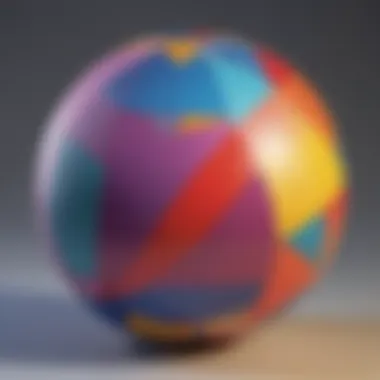Exploring Spheres: Definitions, History, and Applications


Intro
The concept of the sphere is not only a mathematical shape but also a fundamental part of our world. Spheres appear in nature, art, and technology, reflecting both simplicity and complexity. This guide aims to dissect the layers of the sphere, exploring its definition, historical journey, mathematical properties, and its broad applications.
Understanding spheres can inspire curiosity, encouraging young minds to engage with geometry and science. This piece will serve as both a resource and a reference, appealing to elementary school children, parents, and caregivers alike. As we embark on this exploration, we will uncover the significance of spheres in different domains.
Creative Activities
Craft Ideas
Engaging in creative activities helps solidify the understanding of spheres through hands-on experiences. Here are some craft ideas:
- Paper Mache Spheres: Children can create their own spheres using balloons and paper mache techniques.
- Clay Models: Making spheres from clay allows kids to explore tactile properties and shapes.
- Decorative Orbs: Using different materials like yarn or beads, children can decorate spheres to enhance their aesthetic understanding.
Step-by-Step Guides
Each activity can be broken down clearly for easy replication at home or in school.
- Paper Mache Spheres
- Clay Models
- Decorative Orbs
- Inflate a balloon to your desired size.
- Mix glue with water.
- Tear paper into strips and dip into the glue mix.
- Layer the strips over the balloon, allowing to dry.
- Once dry, pop the balloon and paint the sphere.
- Take a ball of soft clay.
- Roll it between your palms to form a perfect sphere.
- Allow it to dry or bake according to clay instructions.
- Start with a small foam ball.
- Use glue to attach yarn or beads, crafting a unique design.
- Finish with a clear coat for longevity.
Educational Value
These activities not only allow for creativity but reinforce critical skills such as hand-eye coordination, spatial awareness, and fine motor skills. Children learn about shapes and geometry in a practical context, fostering deeper understanding and enjoyment.
Fun Quizzes
Quiz Topics
The quizzes can cover a wide range of topics related to spheres:
- What is a sphere?
- Historical significance of spheres.
- Applications of spheres in everyday life.
Question Types
A variety of question types can enhance engagement:
- Multiple choice questions encourage fact recall.
- True or false questions can challenge misconceptions.
- Fill-in-the-blank exercises offer a chance to apply knowledge.
Knowledge Reinforcement
These quizzes help reinforce learning by providing immediate feedback and stimulating further exploration of the topic. They cater to different learning styles, ensuring a broader understanding of spheres.
Fact-Based Articles
Topics
Diverse topics can be covered in related articles, including:
- The mathematics of spheres.
- The role of spheres in physics.
- Cultural meanings and representations of spheres in art.
Engaging Content
These articles exhibit the information in an engaging manner. They are structured clearly, aiding comprehension. Visuals, diagrams, and concise explanations support the narrative, making it accessible for younger audiences.
Understanding the Sphere
The sphere is a fundamental geometric shape that appears in various fields, from mathematics to art and science. Understanding the sphere involves analyzing its properties, significance in different contexts, and applications in the modern world.


One of the key elements to consider is how spheres relate to various disciplines. In geometry, they serve as a perfect representation of three-dimensional space. In nature, spheres can be found in the structure of planets and bubbles, which adds to their allure. This section sheds light on the importance of grasping the concept of spheres, illustrating how they bridge multiple fields and enhance comprehension.
Defining the Sphere
To define a sphere mathematically, one may state that it is the set of all points in three-dimensional space that are equidistant from a fixed point. This fixed point is known as the center, and the distance from the center to any point on the sphere is called the radius. Moreover, the mathematical formula for a sphere's surface connects directly to this definition, showcasing its significance in geometry.
Geometric Properties of Spheres
Spheres exhibit several significant geometric properties, which can enhance one's understanding of their role in mathematics and the physical world.
Radius and Diameter
The radius is a crucial aspect of a sphere. It is the distance from the center of the sphere to any point on its surface. The diameter, in contrast, is twice the length of the radius. This straightforward relationship makes it easy to calculate various sphere properties. Knowing the radius or diameter simplifies calculations when evaluating a sphere's surface area or volume.
- Key Characteristic: The simplicity and unity of calculation are pronounced advantages.
- Unique Feature: The fundamental relationship ensures straightforward conversion between radius and diameter, enhancing comprehension of the sphere’s properties.
Circumference
The circumference of a sphere is the distance around the great circle of the sphere. This is a fundamental measurement that helps in understanding spatial relations. The formula for calculating the circumference is derived directly from the radius, further emphasizing the interconnectivity of the sphere’s properties.
- Key Characteristic: The relationship between the circumference and radius brings clarity to spatial dimensions.
- Unique Feature: This interconnectedness supports deeper insights into geometry, making it appealing for study.
Surface Area
The surface area of a sphere is calculated using the formula: 4πr², where r is the radius. Understanding this property is significant for various practical applications, such as materials estimation in engineering or determining the area of celestial objects.
- Key Characteristic: The surface area formula highlights the relevance of the radius in different applications.
- Unique Feature: It underscores the sphere’s unique characteristics, benefiting those who engage in mathematical concepts.
Volume Calculation
Volume represents the space occupied by a sphere, calculated by the formula: (4/3)πr³. Knowing how to compute volume is essential in several fields including physics and engineering, where it plays a role in capacity measurement.
- Key Characteristic: The practical application of volume in real-world scenarios underscores its importance.
- Unique Feature: Understanding volume allows for application in complex fields, driving interest in further exploration of spheres.
By exploring these geometric properties, both children and adults can appreciate the often-overlooked nuances of spheres. Explaining these concepts in simple terms helps build an appreciation for geometry and its broader applications.
Historical Context
The historical context of spheres provides a fascinating lens through which we can understand their significance across cultures and eras. This section unfolds the layers of how spheres—both as geometric shapes and symbolic objects—are embedded in the narratives of human history. By examining their usage in ancient times and their representation in literary works, we can better appreciate the multifaceted role of spheres in shaping thought and artistry.
Spheres in Ancient Civilizations
In ancient civilizations, spheres represented completeness and unity. They were visible in early architecture and design, demonstrating an understanding of geometry long before modern mathematics took shape. The Greeks, for example, related the sphere to the heavens, associating it with the cosmos itself. This understanding was pivotal; thinkers like Pythagoras and Plato considered the sphere a symbol of perfection.
Artifacts from varied cultures showcase this fascination too. The ancient Egyptians employed spheres in their art, often placing them at the top of obelisks to symbolize a connection to the divine. Similarly, the Chinese utilized spherical designs in their architecture, embodying balance in both physical and metaphysical realms.
These civilizations recognized the sphere not just as a physical object but as a crucial part of their worldview. It helped them explain celestial phenomena, embody philosophical ideas, and inform their artistic expressions. In this way, understanding spheres enriches our knowledge of their impact on ancient life and philosophy.
Spheres in Classical Literature
Literature from antiquity reveals how the sphere's symbolism transcended mere geometric form, embodying themes of wholeness and continuity. Works by authors such as Aristotle and Dante Alighieri illustrate how spheres were employed to explore complex concepts, ranging from the nature of the universe to the human condition. Through these narratives, spheres emerge as powerful symbols that challenge and reflect the realities of existence.
For instance, Dante's "Divine Comedy" uses spherical imagery in its representation of Heaven, Hell, and Purgatory, suggesting their interconnectedness and order. This literary device evokes deeper reflections on morality and the cosmos itself.
Moreover, Aristotle utilized the idea of the sphere in his physics, arguing for the spherical shape of celestial bodies, which reinforced the belief in the immutability of the heavens. These literary references affirm that spheres were not only geometric constructs but also served as vital tools for philosophical contemplation.
Spheres are more than geometric shapes; they are symbols embedded in the fabric of human thought and culture.
In summary, the historical context surrounding spheres reveals their significance in ancient civilizations and classical literature, offering insights into how these forms shaped cultural beliefs, artistic expressions, and philosophical inquiries. Through examining these components, we better understand the enduring legacy of the sphere in science, art, and the human experience.
Mathematics and the Sphere
Mathematics plays a crucial role in understanding the concept of the sphere. Spheres are not just geometrical shapes, they are integral to many fields of science, engineering, and even art. The study of spheres leads to deeper insights in various mathematical disciplines such as geometry and calculus. Understanding how spheres work opens doors to practical applications that impact technology, design, and our perception of space itself.
The Role of Spheres in Geometry


In geometry, the sphere is defined as a perfectly round three-dimensional object, where every point on its surface is equidistant from its center. This definition sets the foundation for numerous geometric principles. One of the primary characteristics of a sphere is its symmetry, which allows for simpler calculations in areas such as surface area and volume.
The formula for the surface area of a sphere is given by A = 4πr², where r is the radius. The volume of a sphere is calculated using the formula V = (4/3)πr³. These equations show the direct relationship between the radius and both the surface area and volume. Such relationships are vital in various real-world applications, from physics to engineering.
"Spheres exhibit uniformity and simplicity that are foundational in the principles of geometry."
Understanding spheres helps students and learners develop critical thinking regarding spatial relationships. This comprehension paves the way to more complex geometric shapes and theorems.
Calculus and Spheres
Each sphere presents an opportunity for calculus to come in play, particularly in understanding concepts such as limits, continuity, and integration. For example, when calculating the volume of a sphere using calculus, one can apply integral calculus to derive the volume formula from the concept of rotation.
To compute the volume using calculus, one can set up an integral of the area of circular slices through the sphere. This approach enhances mathematical understanding and gives insights into how much space a sphere occupies.
In contexts such as physics, the study of spheres can extend to concepts like gravitational fields and forces. The methods used for spheres in calculus provide useful tools for students and mathematicians alike, demonstrating the relevance of mathematical concepts in analyzing physical phenomena.
Through the exploration of these important mathematical ideas, students learn not only about spheres but also gain skills that are applicable in a wide range of scientific fields.
Applications of Spheres
The concept of spheres extends far beyond geometry; it is woven into the very fabric of nature and human innovation. Understanding the applications of spheres provides insight into their significance across various domains. Spheres are unique for their symmetrical properties and efficiency in enclosing space, making them a preferred shape for many natural formations and technological designs. They facilitate simpler calculations in physics and engineering, thereby enhancing our understanding of complex systems.
Spheres in Nature
Celestial Bodies
Celestial bodies such as planets and stars exemplify the natural occurrence of spherical shapes on a massive scale. The key characteristic of celestial bodies is their gravitational forces pulling matter into a round form. This natural design is essential because it allows for uniform distribution of gravitational forces. This uniformity leads to a stable structure, which is beneficial for life processes on planets.
The unique feature of celestial bodies is their vast sizes and the variety of materials that form them. This diversity provides crucial insights into planetary formation, atmosphere composition, and potential habitability. The disadvantage, however, is that interacting with celestial bodies poses challenges due to their distances and environmental conditions.
Bubbles and Soap Films
Bubbles and soap films illustrate another aspect of spheres in nature. These forms occur due to the balance of forces acting on the liquid's surface tension. Bubbles are a charming example of how spheres achieve minimal surface area for a given volume. This property makes them an exceptional illustration of efficiency in nature.
The unique aspect of bubbles and soap films is their ability to represent light and create mesmerizing displays. This makes them a popular choice in educational tools, particularly in demonstrating scientific principles. The disadvantage of bubbles is their fleeting nature; they are not permanent and can easily burst or evaporate, limiting their usage in some applications.
Spheres in Technology
Engineering Applications
In engineering, spheres are fundamental in various designs and structures. Spheres are used in applications like tanks, pressure vessels, and bearings. The key characteristic of spheres in engineering is their ability to withstand uniform pressure from all directions, which increases their durability and efficiency. This makes them a popular shape in many engineering challenges.
A notable feature of spheres is their symmetry and aesthetic appeal, often inspiring architects in designs for buildings. However, a potential disadvantage is that manufacturing spherical objects to precise dimensions can be more challenging than other shapes.
Virtual Reality Models
Virtual reality models utilize spherical shapes for realistic simulations. In virtual environments, spheres are used to create immersive experiences by mimicking the physical world. The key characteristic of virtual reality spheres is their ability to represent distances and object size accurately, significantly enhancing user engagement. This application is beneficial because it opens pathways for education and training in various fields.
The unique feature of virtual reality models is the flexibility they allow in representing complex data in an intuitive manner. However, the challenge lies in the technology's accessibility and cost, which may limit widespread usage in educational contexts.
"The use of spherical shapes in both nature and technology reflects a deep-seated efficiency and stability ingrained in the physical world."
In summary, the applications of spheres in nature and technology are not just fascinating but also crucial for enhancing our understanding of the world. Through examining celestial bodies, bubbles, engineering applications, and virtual reality, we recognize that spheres hold significant relevance across disciplines.
Cultural Significance of Spheres
The sphere is not only a geometric figure; it has profound cultural significance in various realms such as art, architecture, and symbolism. This section explores how spheres impact culture and why they remain significant in understanding human creativity and expression.
Spheres in Art and Architecture
Spheres have captivated artists and architects throughout history. In art, the sphere often represents perfection and unity. Its symmetry and lack of edges make it an ideal symbol of harmony. Artists like Michelangelo and Leonardo da Vinci incorporated spherical elements into their works to convey beauty and balance.
In architecture, spheres can be seen in the design of domes. For instance, the Pantheon in Rome features a massive dome that creates an impression of openness and infinity. This structure symbolizes the connection between the earth and the heavens. Additionally, modern buildings, such as the Spaceship Earth at Epcot Center, exhibit spherical designs, representing innovation and progress.


- Spherical forms create a sense of space within a structure.
- They reflect light beautifully, enhancing the overall aesthetic.
- Incorporating spheres in design can lead to better acoustics and functionality.
Symbolism of Spheres Across Cultures
The symbolism of spheres varies widely across different cultures. In many traditions, spherical shapes are associated with wholeness and eternity. They are thought to represent the universe as a complete, interconnected entity.
For example:
- In Hinduism, the sphere symbolizes the universe and the cosmic cycle of creation and destruction.
- In Buddhism, the mandala, often circular, signifies the cosmos and spiritual journey.
- Ancient Egyptian art frequently used spheres to depict the sun, symbolizing life and power.
The sphere encapsulates deep meanings across ages, portraying ideals such as infinity, completeness, and cosmic unity.
Understanding these symbolic meanings enriches our perspective on cultural artifacts and their purpose. As we observe these shapes in various contexts, we appreciate how deeply interwoven they are in human expression and belief.
Cultural interpretations of spheres not only reflect societal values but also the human desire to comprehend our place in the universe. This ongoing dialogue between form and significance underscores the universal relevance of the sphere.
Spheres in the Modern World
The concept of spheres plays a significant role in many aspects of modern life. Their importance extends across various disciplines, from science to sports. Understanding how spheres function can illuminate their relevance in daily experiences and technological advancements. This section will explore two key areas: the impact of spheres on science and their presence in the world of sports.
The Impact of Spheres on Science
Spheres have a profound influence on several scientific fields. They appear in numerous natural phenomena, notably in physics and astronomy. For instance, celestial bodies such as planets and stars are roughly spherical due to gravitational forces acting on them. The spherical shape allows for a uniform distribution of mass, essential for maintaining balance and stability in cosmic phenomena.
In addition, the study of spheres aids in understanding the laws of physics. The behavior of gases and liquids often adheres to spherical principles. Droplets of water, for instance, naturally take on a spherical form to minimize surface tension. This concept extends to microscopic levels, influencing various fields like biology and chemistry.
Furthermore, spheres are vital in fields like fluid dynamics. The study of how fluids move around spherical objects is crucial for engineering designs and environmental studies. Researchers can develop better models for predicting movements in nature, significantly aiding in disaster management and resource distribution.
"The sphere is one of the most natural and efficient shapes found in nature, illustrating how fundamental geometry can be to understanding complex systems."
Spheres in Sports
Spheres are inherently present in many sports, acting as both equipment and a part of the play. A soccer ball, basketball, or tennis ball is spherical, facilitating predictable movement and interaction. Each sport has adapted the sphere to meet specific goals and regulations, highlighting its versatile nature.
For instance, the dynamics of a soccer ball’s flight explain the principles of aerodynamics. Players must understand how to kick the ball to achieve desired curves and spins, which relies heavily on the path traced by a sphere in motion. In basketball, the spherical shape assists players in making accurate passes and shots, as it rolls and bounces uniformly across surfaces.
Additionally, the design of sports programs and teamwork often emphasize spherical strategies. Players coordinate to pass, shoot, and score, illustrating the importance of the sphere in teamwork dynamics and space utilization on the field.
Understanding the sphere in sports not only enhances gameplay but also teaches fundamental concepts of physics in an engaging manner for young learners. By connecting mathematical ideas with physical activities, educators can foster a deeper appreciation for the sphere in both sports and scientific exploration.
Exploring Spheres in Education
Understanding spheres in an educational setting is crucial. The geometric complexity and real-world applications of spheres make them an essential topic in mathematics and science curricula. By incorporating spheres into learning, educators can enrich students' comprehension of spatial reasoning and geometric figures. This topic not only develops analytical skills but also fosters a sense of wonder about the natural world.
Teaching Geometry with Spheres
Teaching geometry with spheres allows educators to demonstrate key concepts in a tangible way. Spheres are the simplest three-dimensional shapes, and they provide a perfect opportunity to discuss fundamental geometric properties like circumference and surface area. Utilizing spheres, students can visualize and grasp theories that are otherwise difficult to abstract.
One effective approach is to use physical models. Such models can help students see the relationships between radius, diameter, and volume. As students manipulate the models, they engage with the math in a direct way. This hands-on experience promotes deeper learning.
In addition, lessons focused on spheres contribute to a broader understanding of geometry. When we explore spheres, we also indirectly cover aspects of spatial awareness, proportion, and scale. This interconnected learning is beneficial for students of all ages. It builds a solid foundation for advanced mathematical concepts.
Interactive Learning Tools
Interactive learning tools are excellent resources for teaching about spheres. They enhance engagement and understanding among young learners. Two main types of interactive tools are 3D models and virtual simulations.
3D Models
3D Models of spheres are useful because they allow students to observe and manipulate the shape directly. One key characteristic is their tactile nature, which helps students connect with the concept of three-dimensionality. Notably, these models vary in size and material; such variations can spark interest and discussion.
A unique feature of 3D sphere models is their versatility in demonstrations. Educators can visually illustrate formulas for volume or surface area. The advantages of using physical models include improved retention of complex concepts and the encouragement of group work, which fosters collaborative learning. However, one drawback could be the limitation on how many students can engage with a single model simultaneously.
Virtual Simulations
Virtual simulations present another innovative way to explore spheres. These digital tools provide immersive experiences, allowing students to visualize and manipulate spheres in a virtual environment. A key characteristic of virtual simulations is their accessibility; they can be utilized anywhere with internet access.
One unique feature of virtual simulations is the ability to alter parameters dynamically. Students can see in real time how changes in radius or diameter affect volume or surface area. This immediate feedback deepens understanding.
The advantages of virtual simulations include their engaging format and the ability to reach a broader audience. Online platforms often introduce gamified elements, making learning more enjoyable. However, students may also miss the tactile experience that physical models provide, potentially hindering their grasp of three-dimensional shapes.
Interactive learning with spheres is not just about geometry; it’s about inspiring curiosity and innovation across disciplines.







